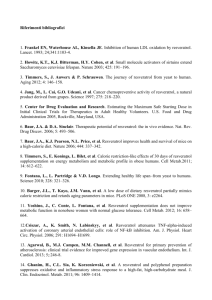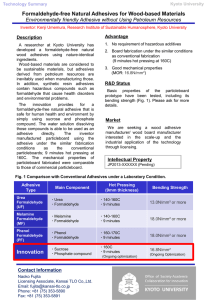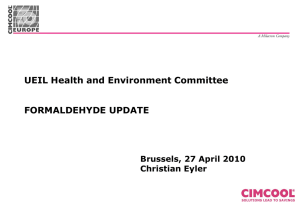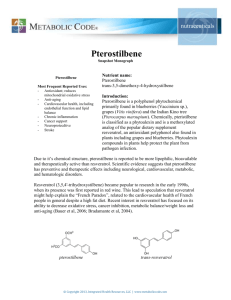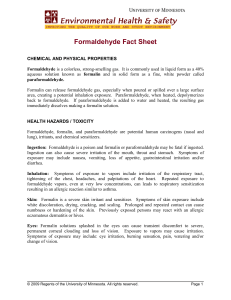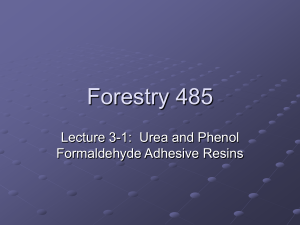REU2014
advertisement
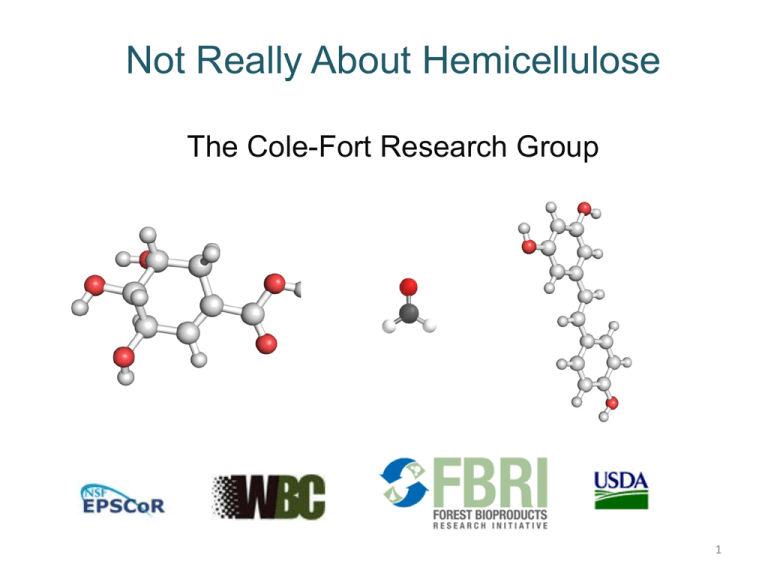
Not Really About Hemicellulose The Cole-Fort Research Group 1 Want to Live to Be 140? Start with calorie restriction (CR): Calorie restriction means a low calorie diet containing all necessary nutrients CR extends the life of C. elegans, Drosophila, mice, and some primates Good health is maintained Resveratrol Found in red wine (pg/mL) Claimed to be responsible for the “French paradox” Mimics the effect of calorie restriction 2 OK, you’re a fat mouse, and we feed you resveratrol: Insulin sensitivity increases Insulin-like growth factor (IGF-1) decreases Peroxisome proliferator increases Motor function improves Alzheimer’s peptide decreases Result: No type II diabetes Reduced risk of cancer Lower blood lipids You make the mouse Olympics More: http://chemistry.umeche.maine.edu/CHY431/Resveratrol.html 3 So we went out in the woods, cut down a bunch of trees, stripped the bark, and made conifer bark tea Grind up the bark Place in the cup of a Soxhlet extractor Boil alcohol and water in the bottom Go home for 24 hours Why the bark? Conifers store antioxidants in the bark to guard against fungi and bark beetles Fungi use oxidative enzymes (laccase, peroxidase) to degrade bark; beetles attack partially degraded bark 5 6 Quantitation by HPLC-MS, GC-MS+SIM Source Resveratrol, mg/g Norway spruce 567 Black Spruce 439 White spruce 382 Eastern White Pine 7.1 Japanese knotweed 523 Grape skins 32.5 Low bush blueberries 12.8 Heirloom tomatoes 1.8 Unsweetened chocolate 1.24 7 Our work with formaldehyde, starts here: Katrina and the infamous FEMA trailers 8 Raw (untreated) wood emits formaldehyde, at room temperature and above! 9 Collecting Formaldehyde Emissions 10 Temperature vs. Formaldehyde Emissions 2000 μg H2CO/g OD wood 1800 1600 1400 1200 1000 800 600 400 200 0 0 50 100 150 200 250 Temperature (oC) 11 Trapped as 2,4,6-trichlorophenylhydrazide, gc-ms+sim analysis Trap 22°C 200°C 1 3.45 1847 2 1.88 7.74 3 2.08 2.25 Total 7.40 1857 ppm formaldehyde, by mass, oven dried wood 12 Higher plants do not make free formaldehyde! 13 Most formaldehyde comes from lignin. How? Trap Crystalline Cellulose Alcell Lignin 1 681 1943 2 21.7 28.9 3 17.3 15.2 Total 719 1987 ppm by mass, air-dried material 14 OH O O OH HO OH HO OH HO CH2OH OH HO H = 75.7 kcal/mol Glucose O HO + + CH2OH O OCH3 OCH3 OH OH Lignin model H = 57.6 kcal/mol (energies from ab initio calculations) 15 OH HO OH O O OCH3 + OCH3 HO CH2O HO OCH3 OCH3 H = 60.1 kcal/mol Lignin model CH2O + CH2O H = - 61.7 kcal/mol CH3OH + H2C O Formaldehyde (energies from ab initio calculations) 16 Enzymatic Hydrolysis of Xylans and Cellulose The goal is to convert these wood components to sugars under mild conditions Immobilization of enzymes on polymer beads would make the enzymatic processes more economical Immobilization also would allow a continuous flow process, rather than batch processing 17 Multiple Enzymes Will Be Required Xylanase OAc O O HO HO O O O AcO O O OH O OH α-Glucuronidase HO H3CO O COOH 18 Hydrolysis of Birch Xylan with the Xylanase from Trichoderma Viride Homology model of T. viride xylanase, based on xylanase from T. reesei 19 Computer “Docking” of a Model Substrate Glu178 Glutamic Acid Glu86 H O H 2N C C OH CH2 CH2 CO2H 20 Hydrolysis of Birch Xylan 4% Sulfuric Acid, 119 oC 21 Enzymatic Hydrolysis, pH 4.5, 35 oC Hardwood hemis hydrolyzed in “green liquor” 22 Another Source of Sugars for Energy OH OH OH HO O O O O HO OH HO O OH O O O O HO OH OH OH Cellulose OH OH HO HO O O HO O OH OH OH Cellobiose 23 Enzymes Homology model of glucohydrolase from Aspergillus niger Glucohydrolase from Trichoderma reesei 24 Lignin-related Molecules Tested As Inhibitors Vanillin p-Coumaric Acid Acetovanillone Vanillic Acid 25 Inhibitors were evaluated by classical enzyme kinetics, using the Lineweaver-Burke technique Average Lineweaver-Burk plots of three replicated trials with and without vanillic acid inhibitor 1 / Velocity (Lh/mol) 30000 y = 16.291x + 11833 R2 = 0.9578 25000 20000 y = 13.983x + 8642.7 R2 = 0.9836 15000 10000 5000 0 -1000 -500 0 500 1000 1500 1 / Cellobiose con.(L/mol) Km, the binding constant, and kcat, the turnover number can be determined from these plots 26 Results of Kinetic Studies For the enzyme from A. niger, the inhibitors tested had no effect within experimental error The enzyme from T. reesei did suffer inhibition of the order of 30-35% with some materials; for example, vanillic acid We now are conducting computational docking studies to explore the mode of interaction of the inhibitors with the enzymes 27 Example Docking Cellobiose (substrate) docked to T. versicolor enzyme p-Coumaric acid docked to A. niger enzyme 28 Formaldehyde Resveratrol Ashley Hellenbrand (MS) Hannah Cole (OHS) Anna Weigang UM Andria Peña-Melendez (REU) Joel Strothers (REU) Regan LeBlanc (MS) Melody Rhine (REU) Dustin Neidt (BS) Panduka Piyaratne Enzymatic Hydrolysis LeRae Graham (PhD) Gamini Rupasinghe (MS) Francis and Robin Avery, Brian Perkins $$ USDA, NSF-EPSCoR, WBC, FBRI Prof. Barbara Cole Prof. Joe Genco Prof. Ray Fort 29 Extra: How does Resveratrol Work? 30 Extra: How Does Resveratrol Work? 31
